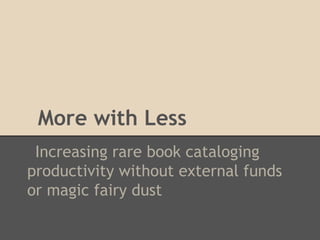
More with less
- 1. More with Less Increasing rare book cataloging productivity without external funds or magic fairy dust
- 2. The Problem Hidden Collections: Library materials that are hidden from patrons because they are uncataloged or otherwise difficult to discover. A 1998 survey of ARL libraries found that 15% of books in special collections were uncataloged.
- 3. Complicating Factors • Even higher percentages of other formats in special collections are "hidden." • Special collections personnel are increasingly expected to focus on digitization, teaching, and other newish initiatives without increased staff levels. Digitization and teaching with special collections materials are both more difficult when collections are uncataloged or unprocessed.
- 4. The Response In the past 15 years, quite a bit of literature about the "hidden collections" problem has circulated throughout the field. The increased focus on this problem has led to an increase in grant funding available for cataloging and processing projects, although that funding is starting to dry up.
- 5. The Solution more money = more staff = more cataloging Otherwise...
- 6. The Survey In 2009, Ann Myers and I issued a survey asking rare book catalogers about their policies and procedures. We were particularly interested in finding whether policies and procedures had changed in response to the "hidden collections" initiative, and if so, how. We also wanted to know whether catalogers felt that these changes were successful and sustainable.
- 7. A few results • 97.8% of respondents reported having a rare book backlog • 55.2% reported having considered changes to rare book cataloging policies and procedures in response to the hidden collections initiative, and 51.1% had actually implemented changes.
- 8. Points of attack 1) Record selection and level: Greater acceptance of existing copy; varying fullness of records; inventory level records; collection level records; discontinuing the use of certain subject headings. 2) Personnel: Allowing paraprofessional catalogers, general collection catalogers, or (gasp!) non-catalogers to do some rare book cataloging. Reducing supervisory review. 3) Priorities: Altering cataloging priorities to emphasize rare materials, or to streamline workflows. 4) Other technical services: Reduction in technical service activities in support of cataloging, such as writing information on flags. 5) Project-based initiatives, grant-funded or otherwise
- 9. Meanwhile, back at Morris Library • In 2008, SCRC held 43,498 cataloged titles, and an estimated 38,500 uncataloged titles. • The majority of cataloged books were arranged in an extremely complicated shelving system, leading to serious organizational problems. • Uncataloged books were interfiled with cataloged books. Additionally, there were several entirely uncataloged large collections. • One faculty cataloger to deal with all of the above with no staff or student support.
- 10. Not all rare books are created equal Our backlog project started by defining the cataloging needs of each collection. Examples: • Early Printed Book Collection: Approximately 500 volumes, requiring full DCRM(B) records. • Open Court Library Collection: Approximately 9,000 volumes, requiring minimal-level records with copy-specific notes The only rule we apply to all books is that perfection may not be the enemy of good.
- 11. More staff = more cataloging Rare Book Librarian's GA: 10 hours per week cataloging (sometimes more), focusing on collections requiring minimal-level cataloging SCRC staff member: 10 hours per week cataloging (sometimes more), focusing on added holdings and copy cataloging newer materials Special Collections Cataloger: Trained and supervised others, created full-level records for early printed books and other materials requiring complex cataloging Rare Book Librarian: Established collection-level cataloging policies and overall cataloging priorities in consultation with the Special Collections Cataloger. Managed all technical services workflows.
- 12. Cataloged books that can't be paged are also hidden Between 2009 and 2011, we "reclassed" approximately 30,000 books that previously had no call numbers. In addition to creating order in the collection, this allowed us to identify the uncataloged books that had been interfiled. These were cataloged by an SCRC staff member. The reclass project was designed by the Special Collections Cataloger, supervised by the Rare Book Librarian, and implemented by fabulous student workers (and Acquisitions staff!).
- 13. Results Early Printed Book Collection: 536 books, fully cataloged Fine Printing Collection: 1644 books, all now have catalog records (some inventory-level) John Dewey Library Collection: 1695 books, fully cataloged Open Court Library Collection: Approximately 9,000 books, 6,669 of which are now cataloged (as of April 2012) New Acquisitions: Cataloged as they come in. We are NOT growing the backlog. Cataloging needs are always considered when potential purchases or donations are evaluated.
- 14. Totals Rare Book Cataloging Stats 2007-2012 8000 6944 7000 6000 5000 4000 3835 3000 2483 2000 1335 1000 494 285 18 74 137 123 18 6 0 2007 2007 2008 2008 2009 2009 2010 2010 2011 2011 2012 2012 Books Serials Books Serials Books Serials Books Serials Books Serials Books Serials
- 15. Lessons Learned • Focus on smaller, manageable projects and prioritize • Question everything (“Why are we doing it this way? Could we make it easier?”) • Collaborate • Stay positive • Unique challenges lead to unique research opportunities